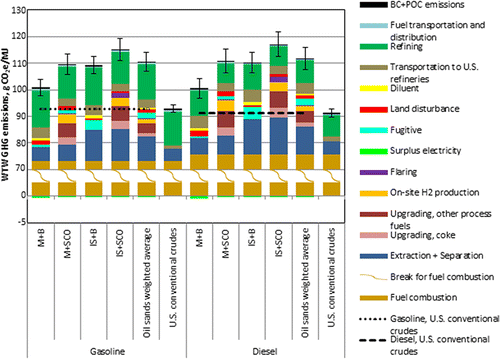Producing fuel from Canada oil sands emits more carbon than from US crude

The production of petroleum from Canada's oil sands is on the rise with much of it destined for U.S. refineries. As the U.S. takes stock of its greenhouse gas emissions, scientists report in the ACS journal Environmental Science & Technology that the current oil sands production of fuels from "well-to-wheels" releases about 20 percent more carbon dioxide into the atmosphere than making gasoline and diesel from conventional crudes.
In 2013, the oil industry was producing nearly 2 million barrels per day from Canadian oil sands. By 2030, that number is expected to rise to just over 4.8 million barrels per day. Studies have estimated the impact of oil sands on greenhouse gas emissions, but the figures have ranged widely, depending on several factors such as the extraction method and refining efficiency. Hao Cai and colleagues wanted to come up with a more detailed assessment.
To calculate the carbon footprint of fuels from Canadian oil sands, the researchers took a more comprehensive approach and incorporated in their formula recent technological upgrades designed to reduce greenhouse gas emissions. Despite the upgrades, they found that gasoline and diesel from Canadian oil sands still released 18 percent and 21 percent more carbon, respectively, into the atmosphere than those same fuels from conventional crude oils that come from U.S. sources.
More information: Well-to-Wheels Greenhouse Gas Emissions of Canadian Oil Sands Products: Implications for U.S. Petroleum Fuels Environ. Sci. Technol., Article ASAP. DOI: 10.1021/acs.est.5b01255
Abstract
Greenhouse gas (GHG) regulations affecting U.S. transportation fuels require holistic examination of the life-cycle emissions of U.S. petroleum feedstocks. With an expanded system boundary that included land disturbance-induced GHG emissions, we estimated well-to-wheels (WTW) GHG emissions of U.S. production of gasoline and diesel sourced from Canadian oil sands. Our analysis was based on detailed characterization of the energy intensities of 27 oil sands projects, representing industrial practices and technological advances since 2008. Four major oil sands production pathways were examined, including bitumen and synthetic crude oil (SCO) from both surface mining and in situ projects. Pathway-average GHG emissions from oil sands extraction, separation, and upgrading ranged from ∼6.1 to ∼27.3 g CO2 equivalents per megajoule (in lower heating value, CO2e/MJ). This range can be compared to ∼4.4 g CO2e/MJ for U.S. conventional crude oil recovery. Depending on the extraction technology and product type output of oil sands projects, the WTW GHG emissions for gasoline and diesel produced from bitumen and SCO in U.S. refineries were in the range of 100–115 and 99–117 g CO2e/MJ, respectively, representing, on average, about 18% and 21% higher emissions than those derived from U.S. conventional crudes. WTW GHG emissions of gasoline and diesel derived from diluted bitumen ranged from 97 to 103 and 96 to 104 g CO2e/MJ, respectively, showing the effect of diluent use on fuel emissions.
Journal information: Environmental Science & Technology
Provided by American Chemical Society
















